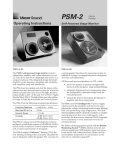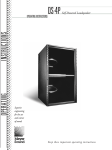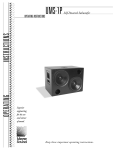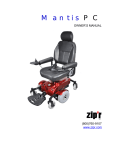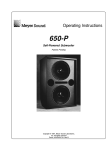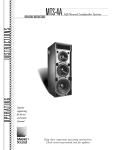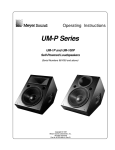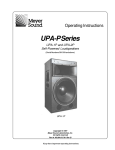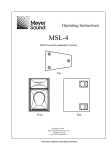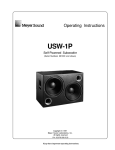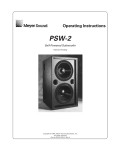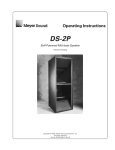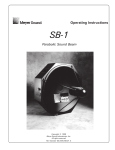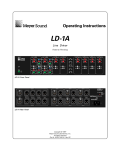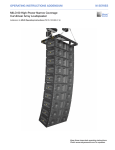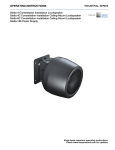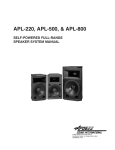Download Meyer Sound Self-Powered Loudspeaker Systems USM-P Series Operating instructions
Transcript
USM-P Series Self-Powered Loudspeaker Systems OPERATING INSTRUCTIONS OPERATING INSTRUCTIONS USM-1P USM-100P Superior engineering for the art and science of sound. Keep these important operating instructions. CONTENTS Safety Summary Introduction and Technical Advantages AC Power The Modular Rear Panel Amplification, Limiting, and Cooling System Coverage Verifying Driver Polarity Troubleshooting Specifications Rear Panel and Input Modules Drawings Dimensions and Contact Information 3 4 4 6 6 7 8 8 10 11 12 SYMBOLS USED THESE SYMBOLS INDICATE IMPORTANT SAFETY OR OPERATING FEATURES IN THIS BOOKLET AND ON THE CHASSIS. ! Dangerous voltages: Important operating risk of electric shock instructions Pour indiquer les risques résultant Pour indequer important instruc- de tensions dangereuses tions Zu die gefahren von gefährliche spanning zeigen Para indicar azares provengo de peligroso voltajes Frame or chassis Protective earth ground Masse, châssis Terre de protection Zu wichtige betriebsanweisung und unterhaltsanweisung zeigen Rahmen oder chassis Die schutzerde Para indicar importante funcionar y mantenimiento instrucciones Armadura o chassis Tierra proteccionista DECLARATION OF CONFORMITY ACCORDING TO ISO/IEC GUIDE AND EN 45014 E NVIRONMENTAL S PECIFICATIONS FOR M EYER S OUND E LECTRONICS P RODUCTS : Operating Temperature 0° to + 45° Nonoperating Temperature <-40°C or > +75°C Humidity to 95% at 35°C Operating Altitude to 4600 m (15,000 ft) Declares that the product: Nonoperating Altitude to 6300 m (25,000 ft) Shock 30g 11 msec half-sine on each of 6 sides Vibration 10Hz to 55Hz (0.010m Conforms to the following Product Specifications peak-to-peak excursion) Safety: EN60065: 1994 1 EMC: EN55103-1 emmission EN55103-2 immunity2 N757 USM-1P The Manufacturer: MEYER SOUND LABORATORIES, INC. 2832 San Pablo Avenue Berkeley, California 94702-2204, USA USM-1P, USM-100P This device complies with the requirements of the Low Voltage Directive 73 / 23 / EEC and the EMC Directive 89 / 336 / EEC. This device also complies with EN 55103-1 & -2. Operation is subject to the following two conditions: (1) this device may not cause harmful interference, and (2) this device must accept any interference received, including interference that may cause undesired operation. 2 N757 USM-100P Made by Meyer Sound Laboratories Berkeley, California USA European Office: Meyer Sound Lab. GmbH Carl Zeiss Strasse 13 56751 Polch, Germany Office of Quality Manager Berkeley, California USA May 18, 2000 ! ENGLISH • To reduce the risk of electric shock, disconnect the loudspeaker from the AC mains before installing audio cable. Reconnect the power cord only after making all signal connections. • Connect the loudspeaker to a twopole, three wire grounding mains receptacle. The receptacle must be connected to a fuse or circuit breaker. Connection to any other type of receptacle poses a shock hazard and may violate local electrical codes. • Do not install the loudspeaker in wet or humid locations without using weather protection equipment from Meyer Sound. • Do not allow water or any foreign object to get inside the loudspeaker. Do not put objects containing liquid on, or near, the unit. • To reduce the risk of overheating the loudspeaker, avoid exposing it to direct sunlight. Do not install the unit near heat-emitting appliances, such as a room heater or stove. • This loudspeaker contains potentially hazardous voltages. Do not attempt to disassemble the unit. The unit contains no user-serviceable parts. Repairs should be performed only by factory-trained service personnel. FRANÇAIS • Pour réduire le risque d’électrocution, débrancher la prise principale de l’haut-parleur, avant d’installer le câble d’interface allant à l’audio. Ne rebrancher le bloc d’alimentation qu’après avoir effectué toutes les connections. • Branchez l’haut-parleur dans une prise de courant à 3 dérivations (deux pôles et la terre). Cette prise doit être munie d’une protection adéquate (fusible ou coupe-circuit). Le branchement dans tout autre genre de prise pourrait entraîner un risque d’électrocution et peut constituer une infraction à la réglementation locale concernant les installations électriques. • Ne pas installer l’haut-parleur dans un SAFETY SUMMARY endroit où il y a de l’eau ou une humidité excessive. • Ne pas laisser de l’eau ou tout objet pénétrer dans l’haut-parleur. Ne pas placer de r´cipients contenant un liquide sur cet appareil, ni à proximité de celui-ci. • Pour éviter une surchauffe de l’hautparleur, conserver-la à l’abri du soleil. Ne pas installer à proximité d’appareils dégageant de la chaleur tels que radiateurs ou appareils de chauffage. • Ce haut-parleur contient des circuits haute tension présentant un danger. Ne jamais essayer de le démonter. Il n’y a aucun composant qui puisse être réparé par l’utilisateur. Toutes les réparations doivent être effectuées par du personnel qualifié et agréé par le constructeur. DEUTSCH • Um die Gefahr eines elektrischen Schlages auf ein Minimum zu reduzieren, den Lautsprecher vom Stromnetz trennen, bevor ggf. ein Audio-Schnittstellensignalkabel angeschlossen wird. Das Netzkabel erst nach Herstellung aller Signalverbindungen wieder einstecken. • Der Lautsprecher an eine geerdete zweipolige Dreiphasen-Netzsteckdose anschließen. Die Steckdose muß mit einem geeigneten Abzweigschutz (Sicherung oder Leistungsschalter) verbunden sein. Der Anschluß der unterbrechungsfreien Stromversorgung an einen anderen Steckdosentyp kann zu Stromschlägen führen und gegen die örtlichen Vorschriften verstoßen. • Der Lautsprecher nicht an einem Ort aufstellen, an dem sie mit Wasser oder übermäßig hoher Luftfeuchtigkeit in Berührung kommen könnte. • Darauf achten, daß weder Wasser noch Fremdkörper in das Innere den Lautsprecher eindringen. Keine Objekte, die Flüssigkeit enthalten, auf oder neben die unterbrechungsfreie Stromversorgung stellen. 3 • Um ein Überhitzen dem Lautsprecher zu verhindern, das Gerät vor direkter Sonneneinstrahlung fernhalten und nicht in der Nähe von wärmeabstrahlenden Haushaltsgeräten (z.B. Heizgerät oder Herd) aufstellen. • Im Inneren diesem Lautsprecher herrschen potentiell gefährliche Spannungen. Nicht versuchen, das Gerät zu öffnen. Es enthält keine vom Benutzer reparierbaren Teile. Reparaturen dürfen nur von ausgebildetem Kundenienstpersonal durchgeführt werden. ESPAÑOL • Para reducir el riesgo de descarga eléctrica, desconecte de la red el altoparlante antes de instalar el cable de señalización de interfaz de la segnale. Vuelva a conectar el conductor flexible de alimentación solamente una vez efectuadas todas las interconexiones de señalizatción. • Conecte el altoparlante a un tomacorriente bipolar y trifilar con neutro de puesta a tierra. El tomacorriente debe estar conectado a la protección de derivación apropiada (ya sea un fusible o un disyuntor). La conexión a cualquier otro tipo de tomacorriente puede constituir peligro de descarga eléctrica y violar los códigos eléctricos locales. • No instale el altoparlante en lugares donde haya agua o humedad excesiva. • No deje que en el altoparlante entre agua ni ningún objeto extraño. No ponga objetos con líquidos encima de la unidad ni cerca de ella. • Para reducir el riesgo de sobrecalentamiento, no exponga la unidad a los rayos directos del sol ni la instale cerca de artefactos que emiten calor, como estufas o cocinas. • Este altoparlante contiene niveles de voltaje peligrosos en potencia. No intente desarmar la unidad, pues no contiene piezas que puedan ser repardas por el usuario. Las reparaciones deben efectuarse únicamente por parte del personal de mantenimiento capacitado en la fábrica. USM-P: INTRODUCTION AND TECHNICAL ADVANTAGES Thank you for investing in the Meyer Sound USM-P Series. The USM-100P and USM-1P self-powered stage monitors are composed of: horn's wider pattern (100°H x 40°V) provides broad coverage in either wedge or flown applications. • one 15-inch cone driver and one 3inch diaphragm compression driver; • phase-corrected, optimized control electronics; • a two-channel amplifier (350Wrms/ch). DESIGN BENEFITS: Compared to conventional monitor designs, Meyer Sound’s USM-P Series loudspeakers are uniquely capable of producing flat phase and amplitude response, full bandwidth reproduction and a near-perfect impulse response. The USM-P boasts a maximum output of 132dB peak SPL at 1 meter with exceptionally low distortion and a noteable lack of coloration at all amplitude levels. An additional benefit of the design engineering and system packaging of the USM-P is its improved linearity and lower susceptibility to feedback. USM-P Series systems excel in stage monitoring applications that require efficient response down to 30Hz for clean, high level reproduction of bass and drums. USM-P Series monitors can be deployed as stage wedges or flown as side-fill. The USM-1P horn's narrow beamwidth (45°H x 45°V) permits precise coverage with minimal interaction between neighboring monitors. The USM-100P • The amplifier is optimized for the system, providing substantial power without endangering the drivers. • The integrated design simplifies setup and installation, eliminates amp racks, and extends the durability and reliability of the loudspeaker. • The gain structure between the control electronics and amplifier is perfectly matched. THE USM-P HORNS: CONSTANT-Q Constant research and development efforts at Meyer Sound have led to the solution of the most difficult problems associated with horn design. In order to appreciate the significance of this work, it is necessary to define an often misunderstood term: the beamwidth of a horn is the angle at which the sound pressure at a given frequency decreases to half (-6dB) its on-axis amplitude. Specifying beamwidth using the -6dB points has been proposed as the audio industry standard; Meyer Sound adheres to this definition. NOTE: Unfortunately, beamwidth is often used to describe the angle at which the sound pressure decreases 10dB from its on-axis amplitude because many listeners perceive this as a decrease to half the SPL. When reading a beamwidth specification, it is essential to determine whether it refers to the -6 or -10dB points because they indicate very different results: the -10dB points yield a wider angle. Previous technologies produced horns whose beamwidth varied over the operating frequency range. These horns also displayed nonuniform frequency response within, and significant side lobe energy outside their beamwidth. Both undesirable characteristics, particularly prevalent for horns with a wide beamwidth, make array design extremely problemactic. The USM-P was developed in Meyer Sound's anechoic chamber by measuring coverage patterns using angular and frequency resolutions of 1° and 1/36 octave, respectively. The USM-P horns exhibit Constant Q: the beamwidth remains consistent across the horn's operating frequency range in both the vertical and horizontal planes. Both horns share the following remarkable attributes: • uniform frequency response within the beamwidth • rapid and uniform amplitude attenuation for all frequencies outside the beamwidth • minimal side lobes AC POWER The USM-P uses a PowerCon locking 3pole AC mains connector that prevents inadvertent disconnection. The unit must have the correct power cord for the AC power in the area in which it will be used. Engagement Separation 1 When AC power is applied to the USM-P, an Intelligent ACtm supply automatically selects the correct operating voltage, allowing the USM-P to be used internationally without manually setting voltage switches. The Intelligent AC supply performs the following protective functions to compensate for hostile conditions on the AC mains: 2 2 1 3 • suppresses high voltage transients up to several kilovolts 4 • filters EMI (radio frequencies and noise present on the AC line) • sustains operation during low-voltage periods, which minimizes audio discontinuity • provides soft-start power-up, which eliminates high inrush current The USM-P can withstand continuous voltages up to 264V and allows any combination of voltage to GND (i.e. Neutral-Hot-GND, Hot-Hot-GND). ! Continuous voltages higher than 264V may damage the unit. VOLTAGE REQUIREMENTS The USM-P operates safely and without audio discontinuity if the AC voltage stays within the range 88-264V, 4763Hz. After applying AC power, the system is muted while the circuitry charges up and stabilizes. After two seconds, the On/Temp. LED on the user panel illuminates green, the system unmutes and is ready to pass audio signals. If the On/Temp. LED does not illuminate or the system does not respond to audio input after ten seconds, consult the Troubleshooting section. The USM-P's power supply uses stored energy to continue functioning for about 10 AC cycles if the voltage decreases below 88V (a condition known as brownout). The precise length of time the unit functions during brownout depends on the operating level and how low the voltage drops. The unit turns off if the voltage does not increase above 88V before the storage circuits are depleted. If the USM-P shuts down due to brownout, the power supply automatically turns on after three seconds if the voltage returns to the normal operating range. If the USM-P does not turn back on after ten seconds, consult the Troubleshooting section. NOTE: We recommend that the supply be operated at least a few volts away from the upper and lower bounds of the operating range to avoid possible shutdown. amount at 115V; the inrush current at 100V is 115% of the 115V amount. The USM-P presents a dynamic load to the AC mains which causes the amount of current to fluctuate between quiet and loud operating levels. Since different types of cables and circuit breakers heat up and trip at varying rates, it is essential to understand the types of current ratings and how they correspond to circuit breaker and cable specifications. The maximum continuous RMS current is the maximum RMS current over a duration of at least 10 seconds. It is used to calculate the temperature increase in cables, which is used to select cables that conform to electrical code standards. It is also used to select the rating for slow-reacting thermal breakers. The maximum burst RMS current is the maximum RMS current over a one second duration. It is used to select the rating for most magnetic breakers. The maximum instantaneous peak current during burst is used to select the rating for fast-reacting magnetic breakers and to calculate the peak voltage drop in long AC cables according to the formula below. Vpkdrop = Ipk x Rtotal cable Use the table below as a guide to select cables and circuit breakers with appropriate ratings for your operating voltage. To determine the minimum total service CURRENT REQUIREMENTS Each USM-P requires approximately 3Arms @115V (1.5Arms@230V) for proper operation. This allows up to five USM-Ps to be powered from one 15A breaker. The maximum burst current of the USM-P is equal to its maximum turn on current. For example, a loud drumbeat which draws 3A can be easily handled by a 20A breaker powering five USM-1Ps. The inrush current at 230V is 50% of the Idle RMS Max. Continuous RMS 115V 230V 10 0 V . 25 A .13A . 3A 2.8A 1.4A 3. 2 A Max. Burst RMS 3. 2 A 1.6 A 3. 7 A Max Peak During Burst 5.0A 2.5A 5.8A power required by a system of USM-P, or other Meyer self-powered speakers, add their maximum continuous RMS currents together. We recommend allowing 5 an additional 30% above the minimum amperage to prevent peak voltage drops at the service entry and nuisance tripping. POWER CONNECTOR WIRING Use the following AC cable wiring diagram to create international or specialpurpose power connectors: brown = hot blue = neutral yellow/green = earth ground (chassis) AC cable color code If the colors referred to in the diagram don't correspond to the terminals in your plug, use the following guidelines: • Connect the blue wire to the terminal marked with an N or colored black. • Connect the brown wire to the terminal marked with an L or colored red. • Connect the green and yellow wire to the terminal marked with an E (or ) or colored green (or green and yellow). SAFETY ISSUES Do not use a ground-lifting adapter or cut the AC cable ground pin. Keep all liquids away from the USM-P to avoid hazards from electrical shock. Do not operate the unit with worn or frayed cables; replace them immediately. If the USM-P will be installed outdoors contact Meyer Sound for information about the rain hood and weather protection for the drivers and electronics. ! While a single USM-P can be hung by its handle bars and fitted L-Track strips, do not hang any additional weight from the cabinet. USM-P handle bars or the L-Track strips mounted on the top front panel are not designed to support heavy rigging loads. THE MODULAR REAR PANEL The rear panel of the USM-P has two slots for processor modules. The top slot contains the Audio Input and Control Module; the bottom slot contains the optional Remote Monitoring System™ (RMS) Module. A blank plate covers the bottom slot if RMS is not installed. For drawings of these modules, see page 11. AUDIO INPUT There are three, interchangeable Audio Input and Control Modules with optimized connectors and controls for different applications. Each module has a 24V Fan connector to power an optional fan (see page 11). Each module uses a three-pin, female XLR audio input connector with a 10kΩ balanced input impedance wired with the following convention: Pin 1 -220 kΩ to chassis and earth ground (ESD clamped) Pin 2 -Signal Pin 3 -Signal Case -Earth (AC) ground and chassis Pins 2 and 3 carry the input as a differential signal. Use standard audio cables with XLR connectors for balanced signal sources. A single audio source can drive multiple USM-Ps with a paralleled input loop, creating an unbuffered hardwired loop connection, with negligible loss in signal level. For example, since the input impedance of one USM-P is 10kΩ, looping 20 USM-Ps produces a balanced input impedance of 500Ω. With a 150Ω audio source, the 500Ω load results in only a 2.28dB loss. in a positive pressure wave when a positive signal is applied to pin 2. With the switch down (-), pin 3 is hot relative to pin 2, resulting in a negative pressure wave when a positive signal is applied to pin 2. The level attenuator knob operates between 0 dB (no level attenuation) in a fully clockwise position to 12 dB in a fully counter-clockwise position. LOOPING AUDIO INPUT MODULE This standard module uses a balanced, female XLR connector for audio input and a male XLR loop connector to interconnect multiple speakers. The audio input connector is hardwired with pin 2 hot to comply with audio industry standards. The loop connector, wired in parallel to the audio input, transmits the input signal if the USM-P is turned off for any reason. LOOPING, POLARITY, AND ATTENUATING AUDIO INPUT MODULE This module has a balanced, female XLR audio input connector, a male XLR loop connector, an input polarity switch, and a level attenuator knob. With the input polarity switch in the up (+) position, pin 2 is hot relative to pin 3, resulting REMOTE MONITORING SYSTEM The USM-P can be equipped to operate with the Remote Monitoring System (RMS) network and software application. RMS displays signal and power levels, driver and cooling fan status, limiter activity, the state of the polarity switch, attenuator level, and amplifier temperature for all speakers in the network on a Windows-based PC. RMS is an excellent field-diagnostic tool that removes the guesswork from troubleshooting during a performance. All Meyer RMS-compatible speakers use the same RMS module (depicted on page 11) so they can be easily exchanged between speakers . Installing an RMS module requires only a Phillips screwdriver. Contact Meyer Sound for more information about RMS. AMPLIFICATION, LIMITING, AND COOLING SYSTEM AMPLIFICATION AND LIMITING Each driver in the USM-P is powered by one channel of a proprietary Meyer Sound amplifier utilizing complementary power MOSFET output stages (class AB, bridged, 350Wrms/ch). Each channel has a limiter that prevents driver over-excursion and regulates the temperature of the voice coil. The limiters protect the drivers without the glaring compression effects imposed by typical limiters, allowing high SPLs across each driver's entire frequency range. Limiter activity for the high and low channels is indicated by two yellow Limit LEDs on the rear panel (the high limit is above the low limit LED). The USM-P performs within its acoustical specifications and operates at a normal temperature if the limit LEDs are on for no longer than two seconds, and off for at least one second. If either LED remains on for longer than three seconds, that channel incurs these negative consequences: • Increasing the input level will not increase the volume. • The system distorts due to clipping and nonlinear driver operation. 6 While the USM-P limiters fully protect the system under overload conditions and exhibits smooth sonic characteristics, we recommend that you do not intentionally drive the USM-P into continuous limiting to attain compression effects. For applications where large amounts of compression are required, we recommend using an outboard compressor/limiter for greater control of limit and compressor effects. AMPLIFIER NATURAL CONVECTION COOLING SYSTEM The USM-P employs a natural convection cooling system that depends on air flow from below the cabinet over the heatsink. Allow for proper ventillation of fresh air when using the speaker. If the temperature of the heatsink reaches 85°C (185°F), the On/Temp. LED on the rear panel turns from green (On) to red (Temp.) and the limiter threshold is lowered to a safe level to prevent the amplifiers from overheating. Under high temperature conditions the limiter threshold is reduced to 6 dB. When the heatsink tmeperature decreas- es to 75°C (167°F), the On/Temp. LED changes from red to green and the limiter threshold returns to normal. ! The heatsink gets too hot to touch during normal operation. Use extreme caution near the rear of the cabinet. FAN ASSEMBLY KIT While convection cooling is adequate for most applications, driving the USMP into frequent limiting under severe temperature conditions, or where ventilation is restricted, an optional fan kit is available to maintain a safe operating temperature. The easy-to-install fan, powered by the 24V Fan user panel connector, blows air directly onto the heatsink. The fan speed increases as the heatsink temperature rises, which maintains a safe operating temperature with minimal fan noise. Contact Meyer Sound to order the fan kit. POWER SUPPLY FAN The power supply is cooled by a single small internal fan that turns on low when the unit is first powered up. The fan doubles its speed as the system is driven with audio. Since the fan draws air in from, and exhausts it out the side of the cabinet, there must be at least six inches on the amplifier's side of the cabinet and adequate air flow. COVERAGE The Constant Q design of the horn allows frequencies outside of the coverage area of the speaker to attenuate quickly. This is excellent for monitoring where several different monitors are used in close proximity. When placing the monitor carefully consider the coverage pattern of the USM-P and USM-100P. The USM-1P's coverage area is: -6 dB points: 45° H x 45° V -10 dB points: 65° H x 65° V The USM-100P's coverage area is: -6 dB points: 100° H x 40° V -10 dB points: 120° H x 60° V The following drawings illustrate the coverage area of each horn from three different perspectives in order to depict the three dimensional coverage pattern. USM-1P (Side View) USM-1P (Front View) USM-100P (Top View) USM-1P (Top View) USM-100P (Side View) USM-1P (Top View) 7 VERIFYING POLARITY Incorrect driver polarity impairs system performance and may damage the drivers. All Meyer Sound loudspeakers are shipped with the drivers in correct alignment. If the driver or circuit wiring has been removed or disassembled it is essential to check the polarity between adjacent monitors and between drivers and between adjacent loudspeakers. POLARITY IN ADJACENT LOUDSPEAKERS 4. Apply the same signal to the second speaker with the first speaker still connected. The polarity is correct if the frequency response remains constant with a 5-6dB SPL increase in amplitude. Broadband cancellation (decreased overall level) indicates polarity reversal. ! Use the following test procedure to verify the polarity between two adjacent loudspeakers of the same type: 1. Position two loudspeakers adjacent to each other. 2. Place a measurement microphone 3ft. from the speakers and 3 to 4 feet above the USM-1Ps, on the axis between the speakers. 3. Connect a signal source to one speaker and note the frequency response and overall level. Since polarity reversal causes excessive driver excursion at high source levels, use moderate levels when conducting these tests. USM-P Reference DRIVER POLARITY IN THE SAME USM-P Use the following test procedure to verify polarity between drivers in the same loudspeaker: 1. Place a monitoring microphone 1 meter from the front of the loudspeaker at the midway point between the high and low frequency drivers. 2. Connect a full range signal to the loudspeaker and note the frequency response. The polarity is correct if the frequency response is smooth through the crossover region (800Hz to 1.5kHz). Cancellation of 6dB or more in this region indicates polarity reversal. 3 Feet USM-P Under Test TROUBLESHOOTING This section suggests several possible solutions to some common problems encountered by USM-P users and is not intended to be a thorough troubleshooting guide. Qualified electronics technicians with access to a test bench can request the following documents from Meyer Sound: Troubleshooting Guide, The Low Frequency Driver Replacement Procedure, and The High Frequency Driver Replacement Procedure for the USM-1P/100P. If your difficulty persists, or if you suspect the problem lies solely within the USM-P, please contact Meyer Sound Technical Support or return the unit to the factory or nearest authorized service center. THE ON/TEMP. LED DOES NOT ILLUMINATE, THERE IS NO AUDIO, AND THE POWER SUPPLY FAN IS OFF. 1. Make sure the AC power cable is the correct type for the regional voltage and that it is securely connected to the AC inlet then unplug and reconnect the AC cable. 2. Use an AC voltmeter to verify that the AC voltage is within the ranges 88-264V, 47-63 Hz. THE ON/TEMP. LED IS ILLUMINATED BUT THERE IS NO SOUND. 1. Verify that the audio source (mixer, EQ, delay) is sending a valid signal. 2. Make sure the XLR cable is securely fastened to the XLR audio input connector. 3. Verify that the XLR cable is functioning by substituting another cable or by using the cable in question in a working system. 4. Send the audio signal to another speaker to insure signal presence and that the level is within the proper range. Turn the source level down before reconnecting the audio input and increase the level slowly to avoid a sudden blast of sound. 8 5. If possible, monitor the audio source with headphones. HUM OR NOISE IS PRODUCED BY THE SPEAKER. 1. Disconnect the audio input. If the hum ceases, the noise originates somwhere earlier in the signal path. If the noise persists, the problem is within the USM-P. 2. Make sure the XLR cable is securely fastened to the XLR audio input connector. 3. Send the audio signal to another speaker to insure signal presence and that the level is within the proper range. Turn the source level down before reconnecting the audio input and increase the level slowly to avoid a sudden blast of sound. 5. Hum or noise can be produced by a ground loop. Since the USM-P is effectively ground-lifted, this should not occur unless grounds are extremely different voltages. THE AUDIO PRODUCED BY THE SPEAKER IS DISTORTED OR COMPRESSED BUT THE LIMIT LIGHT IS NOT ILLUMINATED. 1. Make sure the XLR cable is securely fastened to the XLR audio input connector. 2. Send the audio signal to another speaker to insure that the level is within the proper range. Turn the source level down before reconnecting the audio input and increase the level slowly to avoid a sudden blast of sound. 3. Monitor the audio source with headphones. THE AUDIO PRODUCED BY THE SPEAKER IS HIGHLY COMPRESSED AND THE LIMIT LIGHT IS CONSTANTLY YELLOW. 1. Turn down the level of the input signal to the speaker system. ONLY THE HIGH OR LOW DRIVER SEEMS TO PRODUCE SOUND. 1. Make sure the audio signal is fullrange and has not been filtered in a previous stage of the signal chain. If possible, monitor the audio source with high-quality headphones. 2. Send the audio signal to another speaker to insure that the signal is full-range. Turn the source level down before reconnecting the audio input and increase the level slowly to avoid a sudden blast of sound. 3. Use a sine wave and/or pink noise generator to send a variety of frequencies to the speaker. THERE IS SOME SOUND BUT THE ON/TEMP. LED TURNS FROM GREEN RED. TO This occurs when the heatsink temperature reaches 85°C (185°F), indicating that the amplifier is thermally overloaded. The limiter threshold has dropped to a safe level, so the audio level is probably reduced. 1. Make sure there is enough clearance above, below, and behind the unit. 2. Make sure there is sufficient air flow around the unit. 3. Avoid exposing the heatsink to direct sunlight if the ambient temperature is high. 4. If the ambient temperature is greater 9 than 30°C and this condition occurs frequently, contact Meyer Sound to order the optional Fan Kit. See the section Amplification, Limiting, and Cooling System on page 6 for a complete discussion about the cooling system. THERE IS NO SOUND, THE ON/TEMP. LED IS DIM OR OFF, AND THE POWER SUPPLY FAN IS ON HIGH SPEED. This extremely rare event occurs when the power supply overheats, causing a 1-2 minute interruption in operation. The unit turns on again when the power supply has cooled sufficiently. 1. Make sure there is at least six inches clearance behind the unit. 2. Make sure there is sufficient air flow around the unit. 3. Avoid exposing the unit to direct sunlight in high ambient temperature. See the section Amplification, Limiting, and Cooling System on page 6 for a more information about the power supply's internal fan and cooling system. USM-1P/100-P SPECIFICATIONS Acoustical 1 (each loudspeaker) Operating Frequency Range2 Free Field Half-Space3 Phase Response4 Maximum Peak SPL5 Signal to Noise Ratio 30 Hz - 20 kHz 44 Hz - 16 kHz ±3 dB; -6 dB at 40 Hz and 20 kHz 40 Hz - 16 kHz ±3 dB; -6 dB at 33 Hz and 20 kHz ±35° 500 Hz - 16 kHz; +90° at 120 Hz 132 dB >95 dB (A-weighted noise floor to max SPL) Co ver a g e USM-100P USM-1P -6 db at 100° H x 40° V; -10 dB at 120° H x 60° V -6 db at 45° H x 45° V; -10 dB at 60° H x 60° V Cr osso ver USM-100P USM-1P 900 Hz 1000 Hz Transducers Low Frequency High Frequency S tandar d A u d i o Input Module Type Connector Impedance XLR Wiring RF Filter Common Mode Rejection Ratio Amplifiers Type Output Power THD, IM, TIM A C P ower Connector Automatic voltage selection Idle RMS Current Max Continuous RMS Current (> 10 s) Max Burst RMS Current (<1 s) Max Peak Current During Burst Soft Start Turn-on Physical Dimensions Weight Enclosure/Finish Protective Grill Notes 15-inch cone driver 3-inch diaphragm compression driver Differential balanced input circuit Female XLR; Male XLR Loop 10 kΩ differential (between pins 2 and 3) Pin 1: chassis; Pin 2: + signal; Pin 3: - signal Common Mode: 425 kHz low-pass; Differential Mode: 142 kHz low-pass >80 dB (50 Hz - 1 kHz); typically 90 dB Complementary power MOSFET output stages, class AB/bridged 350 Wrms/channel < .02 % PowerCon locking AC connector 88 - 264 VAC continuous; 47 - 63 Hz 115 V: 0.25 Arms 230 V: 0.13 Arms 115 V: 2.8 Arms 230 V: 1.4 Arms 115 V: 3.2 Arms 230 V: 1.6 Arms 115 V: 5.0 Apk 230 V: 2.5 Apk Inrush current <15 A @115 V 100 V: 0.3 Arms 100 V: 3.2 Arms 100 V: 3.7 Arms 100 V: 5.8 Apk Height: 16.9” (429mm) ; Width: 16.5” (419mm); Length: 22.4” (569mm); Depth (w/grill) 15.19” (386mm) 88 lbs (40 kg) 5/8” birch plywood/black textured Removable perforated steel grill, charcoal grey foam 1. Measurements are taken at 3 m on-axis, 1/3 octave, unless otherwise stated. 2. Response depends on loading conditions and room acoustics. 3. Measured at 1.5 m with the USM-1P/100-P on a single boundary. 4. Phase variation from pure delay. 5. Measured at 1 m, with pink noise or music. Meyer Sound reserves the right to alter any specification without notice. Please visit our web site at www.meyersound.com for up-to-date information. © 2000 Meyer Sound Laboratories, Inc. All rights reserved 10 USER PANEL AND OPTIONAL MODULES The user panel and optional module are described on page 6 of this document. User Panel with RMS option and Polarity and Attenuaing Audio Input Module Looping, Polarity, and Attenuaing Input Module 11 PHYSICAL DIMENSIONS All units in inches. USM-1P USM-100P CONTACT INFORMATION Meyer Sound Laboratories, Inc. 2832 San Pablo Avenue Berkeley, CA 94702 tel: 510.486.1166 fax: 510.486.8356 e-mail: [email protected] http: www.meyersound.com 12 05.089.004.01 Rev A













